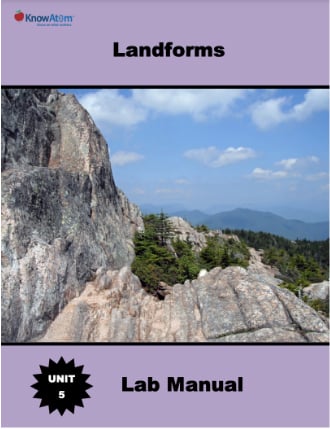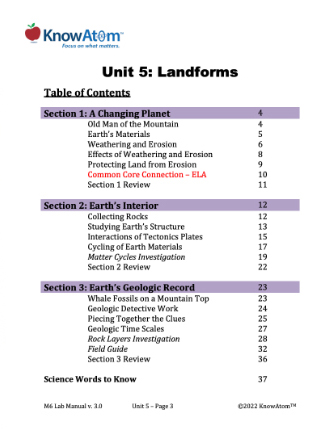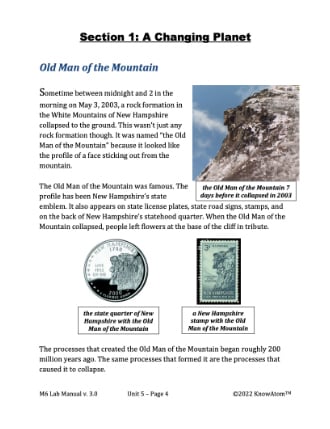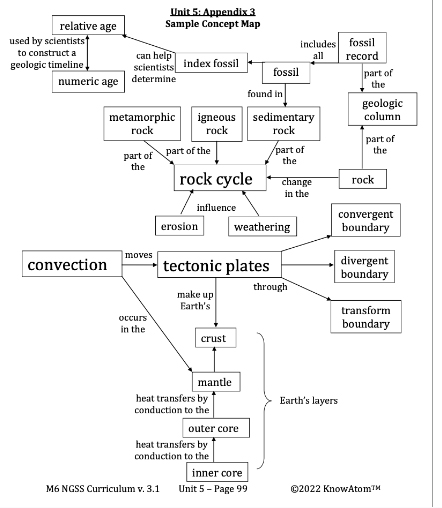Science background provides teachers with more in-depth information on the phenomena students explore in this unit. Below is an excerpt of the science background for teachers from this lesson on Earth’s geologic history.
The Rock Cycle
The movement of the tectonic plates contributes to the cycling of Earth materials, and plays an important role in the rock cycle. The rock cycle refers to the processes that form, break down, and re-form rock from one category to another. Weathering and erosion are also processes that drive the cycling of rocks.
Geologists broadly classify rocks based on their properties and how they were formed. Each type of rock requires a different combination of heat, pressure, and time.
Sedimentary rock forms from layers of sand, soil, mud, plant remains, and other sediment that build up in one location over time. Sediment is a collection of particles and pieces of living and nonliving things. Over thousands of years, the intense pressure of increasing layers of sediment above presses the layers into solid rock. Chemical weathering by substances such as acid rain hastens the process of large rocks becoming small pieces of sediment. Limestone, sandstone, shale, and gypsum are common sedimentary rocks.
Each layer in a sedimentary rock formation represents a period of time, often with different climates or geography. The oldest sediment forms the bottommost layers of the rock, while newer layers replace each other at the top. Geologists can read the size, shape, and arrangement of sedimentary particles to get an idea of the environmental conditions of Earth over time.
Categories of Rock
Metamorphic rock is rock formed in chemical reactions where one type of rock is changed by pressure or heat into a new type of rock with different properties. Metamorphose means “to change” or “to transform.” For example, with enough time, heat, and pressure, the soft sedimentary rock limestone is chemically changed into hard marble. Metamorphic rocks are much harder than sedimentary rocks but show some signs of their past layers. Metamorphism can occur in the subduction zone, at the bottom of heavy piles of sediment, or where continents collide. Slate, gneiss, and marble are examples of metamorphic rock.
Igneous rock forms when hot liquid rock (either magma or lava) cools into solid form. The word igneous means “from fire.” Mineral grains start to form as magma cools. The texture of igneous rock is determined by the rate of cooling. Magma that slowly cools deep in Earth’s crust solidifies slowly, yielding coarse rocks like granite and occasionally gems like diamonds. Lava, which is magma that reaches Earth’s surface after a volcanic eruption, cools quickly and is hard and finely grained.
Volcanoes are mountainous vents that release the contents of Earth’s mantle onto the surface. The gas and magma that come out of volcanoes can spread ash into the atmosphere and create islands and other landforms.
Volcanoes can be active, dormant, or extinct. This is determined by how close a volcano is to a magma source, called a hot spot. Because tectonic plates are moving, cracks in the surface can move away from hot spots and cause a volcano to become dormant. If the cracks move far enough away from the hot spot, we say the volcano is extinct.
Studying Rocks for Clues
Geologists are like detectives, looking for clues in the layers of rock that make up Earth’s surface that tell them about how Earth has changed since it first formed 4.6 billion years ago.
Understanding layers is an important part of this geologic detective work. The rock layers and the fossils found in them are called the geologic column. Fossils are the remains of ancient animals and plants, the traces or impressions of living things from past geologic ages, or the traces of their activities. Sedimentary rock often holds fossils because its layers built up over time. As sediment was deposited, it often trapped and preserved remains of living things. These remains include whole plants and animals, as well as traces of organisms such as footprints.
Geologists refer to the rock strata when talking about the layered arrangement of rocks in the geologic column. Scientists know that when they look at rock strata, the bottom layer is generally the oldest layer. The top layer is the newest, most recent layer. This is because of the process of sedimentation. Sediment formed from weathering and erosion slowly accumulates in layers in oceans, lakes, and valleys over time. Each new layer is deposited on top of an older layer. This process also results in layers that are horizontal. In other words, the layers are parallel (or mostly parallel) to Earth’s surface.








